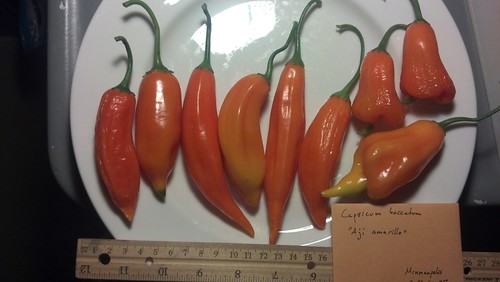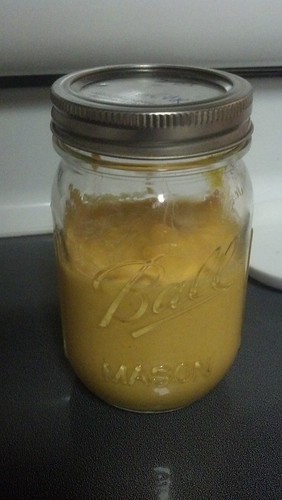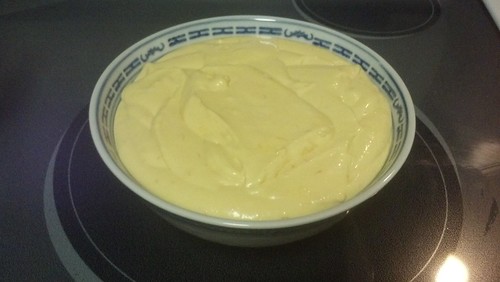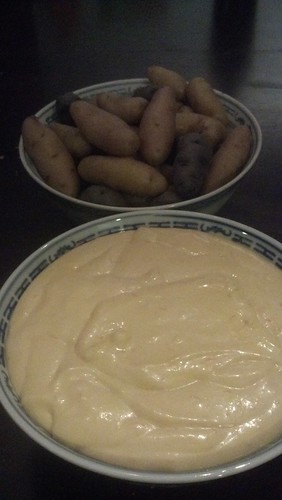My aji amarillo crop and my freetime finally coincided, and I had the chance to make some Peruvian goodies.
The first one is an all-purpose chili paste, one of the cornerstones of Peruvian food: pasta aji amarillo, or yellow pepper paste.
First off, the pepper paste:
Start with about a pound of ripe amarillo peppers. For some strange reason, they're deep orange in color when they're ready, but you'll see later on why they're 'yellow' and not 'orange'.

Cut off the ends, take out the seeds, and then boil them in just enough water to cover them for three minutes. Add a dash of milk to extract some of the capsaicin (in Perú, this is a very mild, all-purpose paste.) After three minutes, throw out the water, and replace it again with more water and a little milk, and repeat the process again. Do this one more time, and the peppers are ready.
After that's all done,the peppers are fully cooked, and can be made into paste. Throw them in a blender,. add a couple tablespoons of canola oil or vegetable oil, a pinch of salt, and blend until smooth.
The flavor of this is bright, fresh, and and intense, "like sunshine in a jar". As you can see, the color has turned to an intense yellow hue:

With this in hand, we're ready to move onto the real sauce.
You'll need:
Throw the yellow pepper paste, the cheese, the garlic, and the evaporated milk together, and blend them using a hand mixer. This should make a nice, thick sauce. If it's too thin, add a few saltines, and blend them in. If it's too thick, add a little milk.
The result is a creamy, spicy, tangy bowl of deliciousness.

This sauce has all sorts of purposes, but one of the more traditional ones is in papa a la Huancaína (Huancayo-style potatoes.) One variation that is fun is to use fingerling or new potatoes to dip into it. The potatoes are bit-sized and extra sweet, making a really great hors d'oeuvres.

(Get ready for flavor!)
The first one is an all-purpose chili paste, one of the cornerstones of Peruvian food: pasta aji amarillo, or yellow pepper paste.
First off, the pepper paste:
Start with about a pound of ripe amarillo peppers. For some strange reason, they're deep orange in color when they're ready, but you'll see later on why they're 'yellow' and not 'orange'.

Cut off the ends, take out the seeds, and then boil them in just enough water to cover them for three minutes. Add a dash of milk to extract some of the capsaicin (in Perú, this is a very mild, all-purpose paste.) After three minutes, throw out the water, and replace it again with more water and a little milk, and repeat the process again. Do this one more time, and the peppers are ready.
After that's all done,the peppers are fully cooked, and can be made into paste. Throw them in a blender,. add a couple tablespoons of canola oil or vegetable oil, a pinch of salt, and blend until smooth.
The flavor of this is bright, fresh, and and intense, "like sunshine in a jar". As you can see, the color has turned to an intense yellow hue:

With this in hand, we're ready to move onto the real sauce.
You'll need:
- 1/2 c. pasta aji amarillo
- 1 clove of garlic, peeled
- 2 c of a semi-firm white cheese, like queso fresco, queso Oaxaca, or farmer cheese
- 12 oz of evaporated milk
- saltines and milk (optional)
Throw the yellow pepper paste, the cheese, the garlic, and the evaporated milk together, and blend them using a hand mixer. This should make a nice, thick sauce. If it's too thin, add a few saltines, and blend them in. If it's too thick, add a little milk.
The result is a creamy, spicy, tangy bowl of deliciousness.

This sauce has all sorts of purposes, but one of the more traditional ones is in papa a la Huancaína (Huancayo-style potatoes.) One variation that is fun is to use fingerling or new potatoes to dip into it. The potatoes are bit-sized and extra sweet, making a really great hors d'oeuvres.

(Get ready for flavor!)




